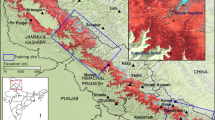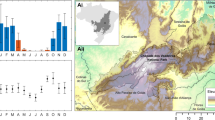Abstract
Coastal marshlands may provide ecosystem services but their vegetation and related services may be impacted by environmental changes. Habitat mapping is a key step to monitor the spatio-temporal dynamics of vegetation and detect on-going changes. However, it is still a challenge to produce reliable vegetation maps at the regional scale. This study aims to evaluate the potential of new Landsat-8 imageries (acquired in September and December 2013) for mapping fine-grained plant communities in coastal marshlands. Field-based vegetation maps were collected for 270 km of marshlands along the French Atlantic coast. In order to be identifiable on the satellite image, fine-grained vegetation units were aggregated into fewer plant community combinations. The classification accuracy was assessed by comparison with field-based vegetation data and compared between the supervised methods used, including Minimum Distance, Mahalanobis, Maximum Likelihood, Random Forest and Support Vector Machine. The best result was obtained with the Maximum Likelihood classifier and by combining the two Landsat-8 images (85.9 % accuracy overall). Three main habitat types dominated the coastal Atlantic marshlands: croplands, Trifolio maritimae-Oenantheto silaifoliae geosigmetum and Puccinellio maritimae-Arthrocnemeto fruticosi geosigmetum. The reliability of the vegetation map produced will provide a good basis for monitoring the conservation status of the various habitats.



Similar content being viewed by others
References
Akumu CE, Pathirana S, Baban S, Bucher D (2010) Monitoring coastal wetland communities in north-eastern NSW using ASTER and Landsat satellite data. Wetl Ecol Manag 18:357–365
Amiaud B, Bouzillé JB, Tournade F, Bonis A (1998) Spatial patterns of soil salinities in old embanked marshlands in western France. Wetlands 18:482–494
Baker C, Lawrence R, Montagne C, Patten D (2006) Mapping wetlands and riparian areas using Landsat etm1 imagery and decision-tree-based models. Wetlands 26:465–474
Barillé L, Robin M, Harin N, Bargain A, Launeau P (2010) Increase in seagrass distribution at bourgneuf bay (France) detected by spatial remote sensing. Aquat Bot 92:185–194
Berberoglu S, Yilmaz KT, Özkan C (2004) Mapping and monitoring of coastal wetlands of çukurova delta in the eastern Mediterranean region. Biodivers Conserv 13:615–633
Biondi E, Casavecchia S, Pesaresi S (2011) Spontaneus renaturalization processes of the vegetation in the abandoned fields (central Italy). Ann di Bot 6:65–94
Bouzillé JB, Kernéis E, Bonis A, Touzard B (2001) Vegetation and ecological gradients in abandoned salt pans in western France. J Veg Sci 12:269–278
Breiman L (2001) Random forests. Mach Learn 45:5–32
Cardoso GF, Jr CS, PWM S-F (2013) Using spectral analysis of landsat-5 TM images to map coastal wetlands in the amazon river mouth, Brazil. Wetl Ecol Manag 22:79–92
Carreño MF, Esteve MA, Martinez J, et al (2008) Habitat changes in coastal wetlands associated to hydrological changes in the watershed. Estuar Coast Shelf Sci 77:475–483
Chauveau E, Chadenas C, Comentale B, Pottier P, Blanlœil A, Feuillet T, Mercier D, Pourinet L, Rollo N, Tillier I, Trouillet B (2011) Xynthia: lessons of a disaster. Cybergeo: Eur J Geogr. doi:10.4000/cybergeo.23763
Cingolani AM, Renison D, Zak MR, Cabido MR (2004) Mapping vegetation in a heterogeneous mountain rangeland using Landsat data: an alternative method to define and classify land-cover units. Remote Sens Environ 92:84–97
Congalton RG, Oderwald RG, Mead RA (1983) Assessing Landsat Classification accuracy using discrete multivariate analysis statistical techniques. Photogramm Eng Remote Sens 49:1671–1678
Decocq G (2002) Patterns of plant species and community diversity at different organization levels in a forested riparian landscape. J Veg Sci 13:91–106
Dimitriadou E, Hornik K, Leisch F, et al (2011) e1071: misc functions of the department of statistics (e1071), TU Wien. R Package version 1.5–27.
Dumont B, Rossignol N, Loucougaray G, Carrère P, Chadoeuf J, Fleurance G, Bonis A, Farruggia A, Gaucherand S, Ginane C, Louault F, Marion B, Mesléard F, Yavercovski N (2012) When does grazing generate stable vegetation patterns in temperate Pastures? Agric Ecosyst Environ 153:50–56
Duncan P, Hewison AJM, Houte S, Rosoux R, Tournebize T, Dubs F, Burel F, Bretagnolle V (1999) Long-term changes in agricultural practices and wildfowling in an internationally important wetland, and their effects on the guild of wintering ducks. J Appl Ecol 36:11–23
Géhu J-M (2011) On the opportunity to celebrate the centenary of modern phytosociology in 2010. Plant Biosyst 145:4–8
Géhu JM, Bouzille JB, Bioret F, Godeau M, Botineau M, Clement B, Touffet J, Lahondere C (1991) Approche paysagere symphytosociologique des Marais littoraux du centre-Ouest de la France. Colloques Phytosociologique Phytosociologie et Paysages 17:109–127
Godet L, Thomas A (2013) Three centuries of land cover changes in the largest French Atlantic wetland provide new insights for wetland conservation. Appl Geogr 42:133–139
Grimaldi M, Oszwald J, Dolédec S, et al (2014) Ecosystem services of regulation and support in Amazonian pioneer fronts: searching for landscape drivers. Landsc Ecol 29:311–328
Grime JP (2006) Plant strategies, vegetation processes, and ecosystem properties. John Wiley& Sons, Chichester
Hijmans RJ, van Etten J (2012) Raster: geographic analysis and modeling with raster data. R Package Version 2.0–12
Hoekstra JM, Molnar JL, Jennings M, et al (2010) The atlas of global conservation: changes, challenges and opportunities to make a difference. University of California Press Berkeley, CA
Isacch JP, Costa CSB, Rodríguez-Gallego L, Conde D, Escapa M, Gagliardini DA, Iribarne OO (2006) Distribution of saltmarsh plant communities associated with environmental factors along a latitudinal gradient on the south-west Atlantic coast. J Biogeogr 33:888–900
Jarvis A, Reuter H, Nelson A, Guevara E (2008) Hole-filled SRTM for the globe Version 4. Available from the CGIAR-CSI SRTM 90 m database. http://srtm.csi.cgiar.org
Jelinski DE, Wu J (1996) The modifiable areal unit problem and implications for landscape ecology. Landsc Ecol 11:129–140
Jia K, Wei X, Gu X, Yao Y, Xie X, Li B (2014) Land cover classification using Landsat 8 Operational Land Imager data in Beijing, China. Geocarto International 1–11
Kennedy RE, Andréfouët S, Cohen WB, et al (2014) Bringing an ecological view of change to Landsat-based remote sensing. Front Ecol Environ 12:339–346
Kirwan ML, Guntenspergen GR, D’Alpaos A, Morris JT, Mudd SM, Temmerman S (2010) Limits on the adaptability of coastal marshes to rising sea level. Geophys Res Lett 37:L23401
Lang S, Mairota P, Pernkopf L, Schioppa EP (2015) Earth observation for habitat mapping and biodiversity monitoring. Int J Appl Earth Obs Geoinf 37:1–6
Lee TM, Yeh HC (2009) Applying remote sensing techniques to monitor shifting wetland vegetation: a case study of Danshui river estuary mangrove communities, Taiwan. Ecol Eng 35:487–496
Leguédois S, Party JP, Dupouey JL, Gauquelin T, Gégout JC, Lecareux C, Badeau V, Probst A (2011) The vegetation map of the CNRS going numerical: the geographical database of the vegetation of France. Cybergeo : Eur J Geogr. doi:10.4000/cybergeo.24688
Li J, Gao S, Wang Y (2010) Invading cord grass vegetation changes analyzed from Landsat-TM imageries: a case study from the wanggang area, Jiangsu coast, eastern China. Acta Oceanol Sin 29:26–37
Liaw A, Wiener M (2002) Classification and regression by randomForest. R News 2:18–22
MacAlister C, Mahaxay M (2009) Mapping wetlands in the lower Mekong basin for wetland resource and conservation management using Landsat ETM images and field survey data. J Environ Manag 90:2130–2137
Marion B, Bonis A, Bouzillé J-B (2010) How much does grazing-induced heterogeneity impact plant diversity in wet grasslands? Ecoscience 17:229–239
Mitsch WJ, Gosselink JG (2007) Wetlands. John Wiley and Sons, Inc., Hoboken
Mountrakis G, Im J, Ogole C (2011) Support vector machines in remote sensing: a review. ISPRS J Photogramm Remote Sens 66:247–259
Murgues M, Marquet M, Debaine F (2014) Cartographie des formations végétales des zones humides du parc naturel régional de brière par analyse d’image orientée-objet. Les Cahiers Nantais 5–16(in french)
Ottinger M, Kuenzer C, Liu G, et al (2013) Monitoring land cover dynamics in the yellow river delta from 1995 to 2010 based on Landsat 5 TM. Appl Geogr 44:53–68
Ozenda P, Lucas MJ (1987) Esquisse d’une carte de la végétation potentielle de la France à 1/1 500 000. Documents Cartographie écologique 30:49–80
Rapinel S, Clément B, Magnanon S, Sellin V, Hubert-Moy L (2014) Identification and mapping of natural vegetation on a coastal site using a worldview-2 satellite image. J Environ Manag 144:236–246
Rapinel S, Hubert-Moy L, Clément B (2015) Combined use of LiDAR data and multispectral earth observation imagery for wetland habitat mapping. Int J Appl Earth Obs Geoinf 37:56–64
Richards JA (1999) Remote sensing digital image analysis: an introduction. Springer-Verlag, New York
Rivas-Martinez S (2005) Notions on dynamic-catenal phytosociology as a basis of landscape science. Plant Biosyst 139:135–144
Roelofsen HD, Kooistra L, van Bodegom PM, Verrelst J, Krol J, Witte JPM (2014) Mapping a priori defined plant associations using remotely sensed vegetation characteristics. Remote Sens Environ 140:639–651
Saintilan N, Wilson NC, Rogers K, et al (2014) Mangrove expansion and salt marsh decline at mangrove poleward limits. Glob Chang Biol 20:147–157
Sanchez-Hernandez C, Boyd DS, Foody GM (2007) Mapping specific habitats from remotely sensed imagery: support vector machine and support vector data description based classification of coastal saltmarsh habitats. Ecol Inf 2:83–88
Sawtschuk J, Bioret F (2012) Diachronic analysis of vegetation spatial dynamic in Loire esturay. Photo-Interpretation 48:15–28
Schmeller DS, Evans D, Lin Y-P, Henle K (2014) The national responsibility approach to setting conservation priorities—recommendations for its use. J Nat Conserv 22:349–357
Schmidtlein S (2003) Raster-based detection of vegetation patterns at landscape scale levels. Phytocoenologia 33:603–621
Schuster C, Schmidt T, Conrad C, et al (2015) Grassland habitat mapping by intra-annual time series analysis – comparison of RapidEye and TerraSAR-X satellite data. Int J Appl Earth Obs Geoinf 34:25–34
Turner W, Rondinini C, Pettorelli N, et al (2015) Free and open-access satellite data are key to biodiversity conservation. Biol Conserv 182:173–176
Valentini E, Taramelli A, Filipponi F, Giulio S (2015) An effective procedure for EUNIS and Natura 2000 habitat type mapping in estuarine ecosystems integrating ecological knowledge and remote sensing analysis. Ocean Coast Management 108:52–64
Van der Maarel E (2005) Vegetatio ecology – an overwiew. In : Vegetation ecology. Edit eddy van der maarel. 1–51. Blackwell Publishing, Malden.
Vanden Borre J, Paelinckx D, Mücher CA, Kooistra L, Haest B, De Blust G, Schmidt AM (2011) Integrating remote sensing in Natura 2000 habitat monitoring: prospects on the way forward. J Nat Conserv 19:116–125
Verger F (2005) Marais et estuaires du littoral français. Belin, Paris
Xie Y, Sha Z, Yu M (2008) Remote sensing imagery in vegetation mapping: a review. J Plant Ecol 1:9–23
Zak MR, Cabido M (2002) Spatial patterns of the Chaco vegetation of central Argentina: integration of remote sensing and phytosociology. Appl Veg Sci 5:213–226
Zhang Y, Lu D, Yang B, et al (2011) Coastal wetland vegetation classification with a Landsat thematic mapper image. Int J Remote Sens 32:545–561
Acknowledgments
This research was funded by the CarHab project (French Ministry of Ecology and Sustainable Development). The authors thank Olivier Gore for his help in the field ; Nicolas Rossignol, Renan Leroux and Alban Thomas for their help in data analysis; the GIP Loire Estuaire, DREAL Pays de la Loire, DREAL Poitou Charentes, and the Parc Naturel Régional du Marais Poitevin for providing the field-based vegetation maps.
Author information
Authors and Affiliations
Corresponding author
Rights and permissions
About this article
Cite this article
Rapinel, S., Bouzillé, JB., Oszwald, J. et al. Use of bi-Seasonal Landsat-8 Imagery for Mapping Marshland Plant Community Combinations at the Regional Scale. Wetlands 35, 1043–1054 (2015). https://doi.org/10.1007/s13157-015-0693-8
Received:
Accepted:
Published:
Issue Date:
DOI: https://doi.org/10.1007/s13157-015-0693-8




